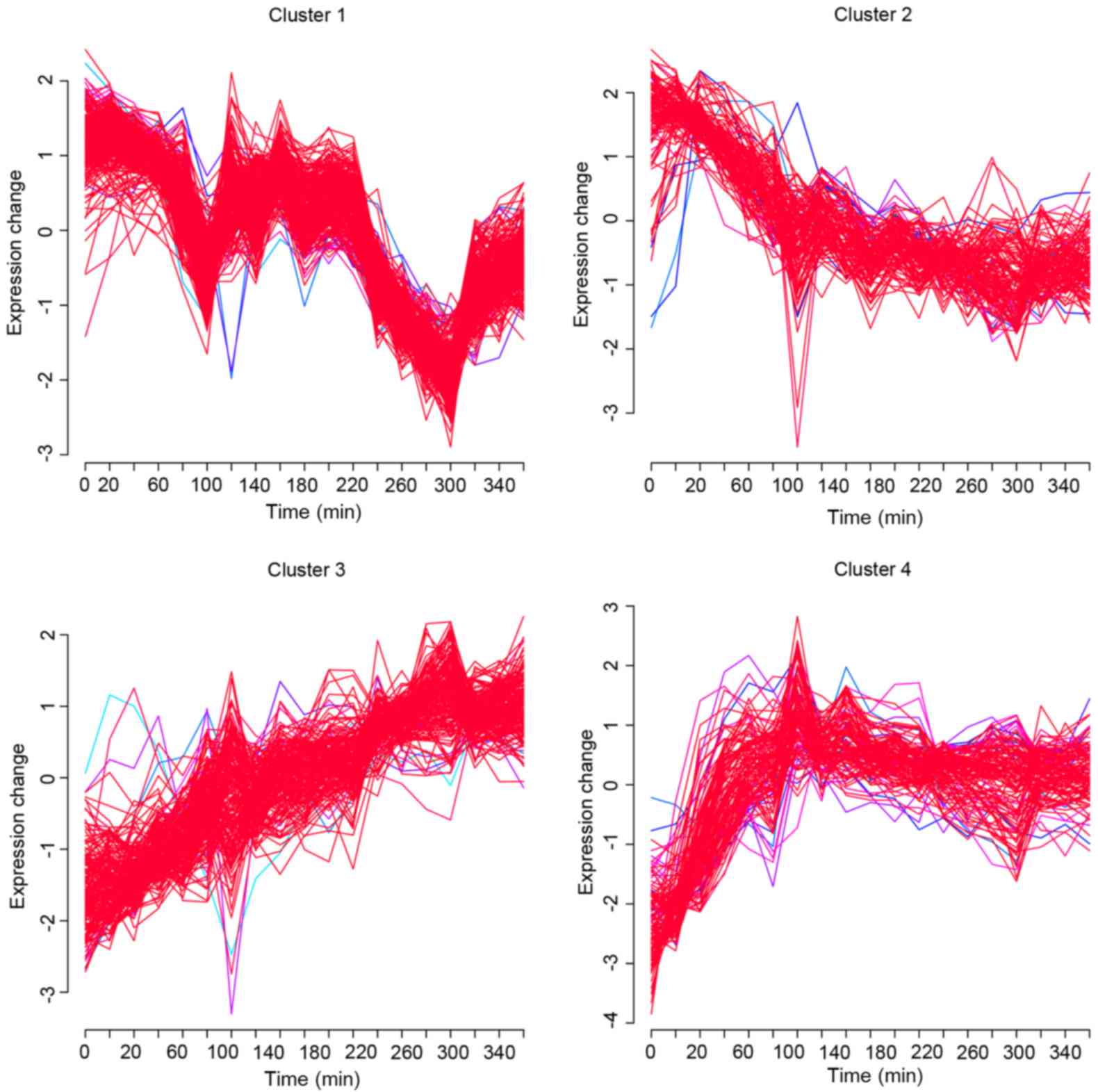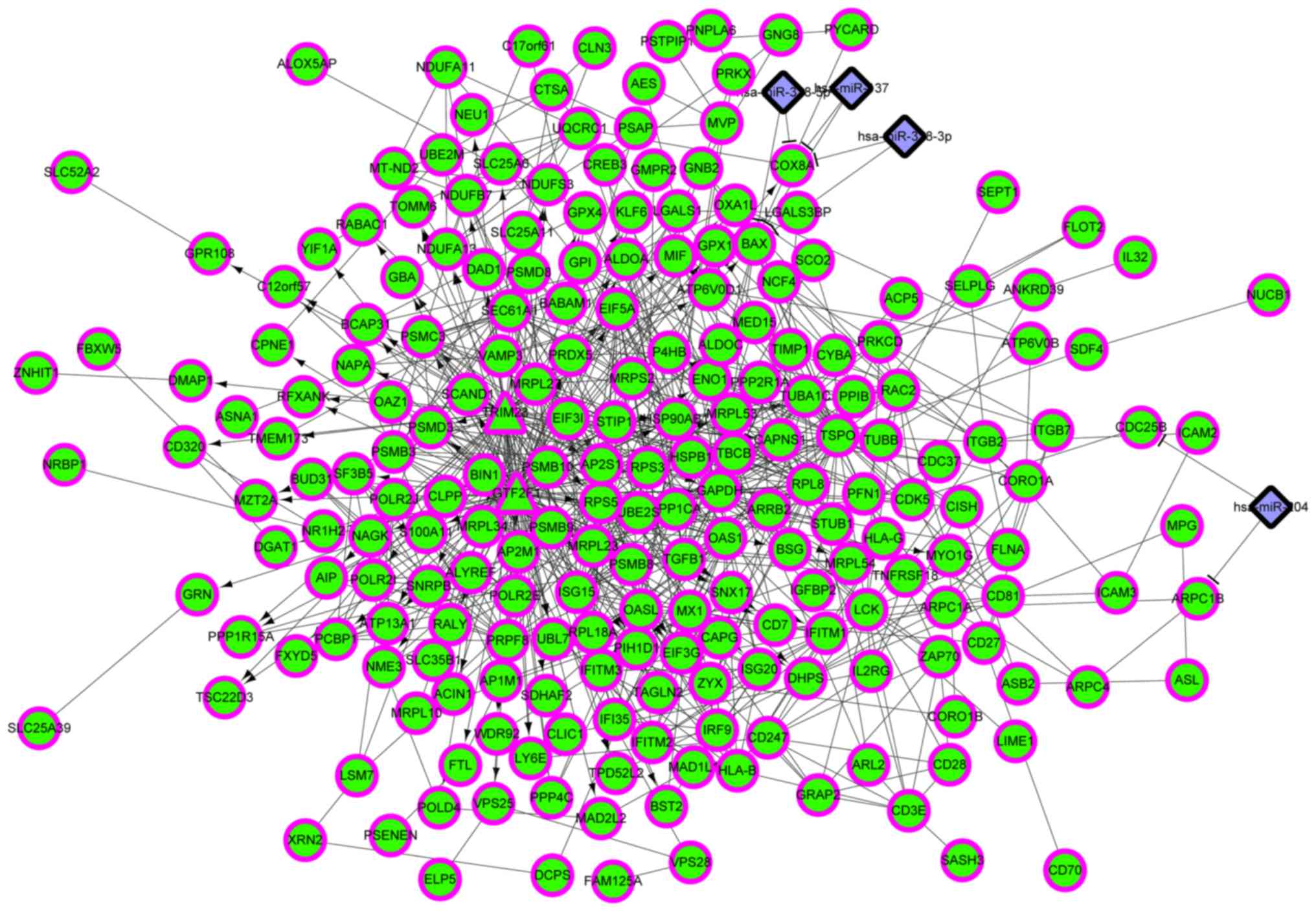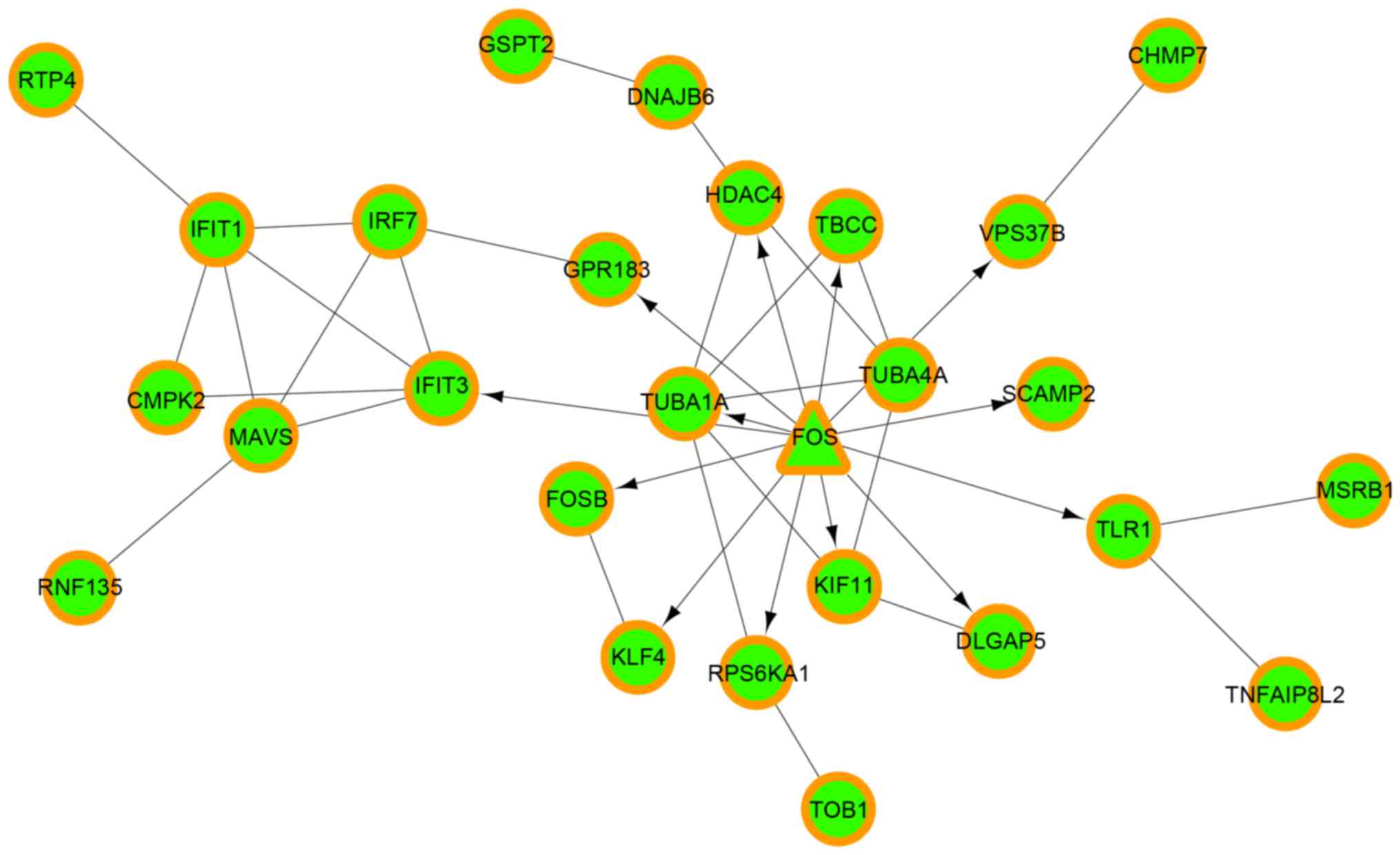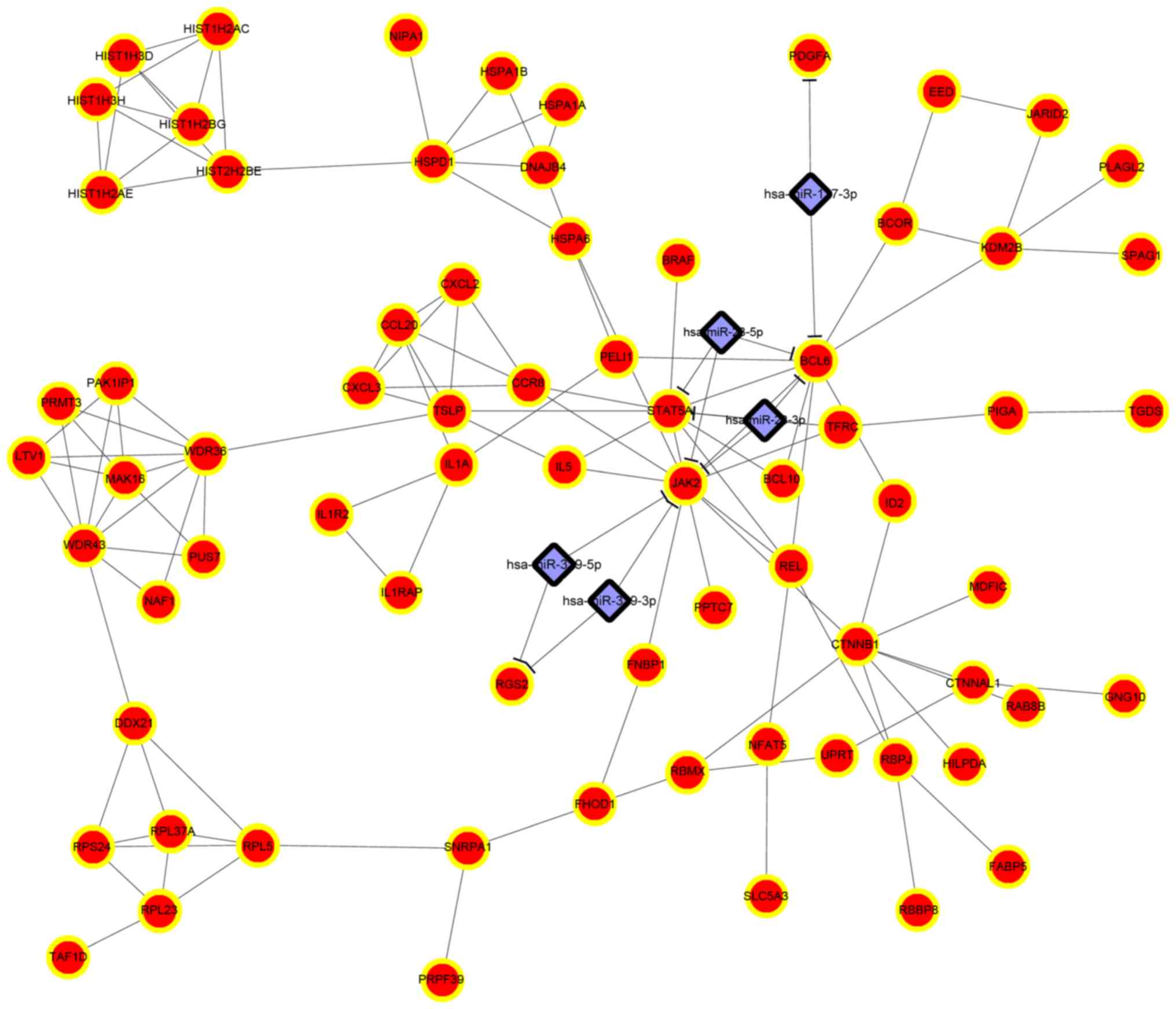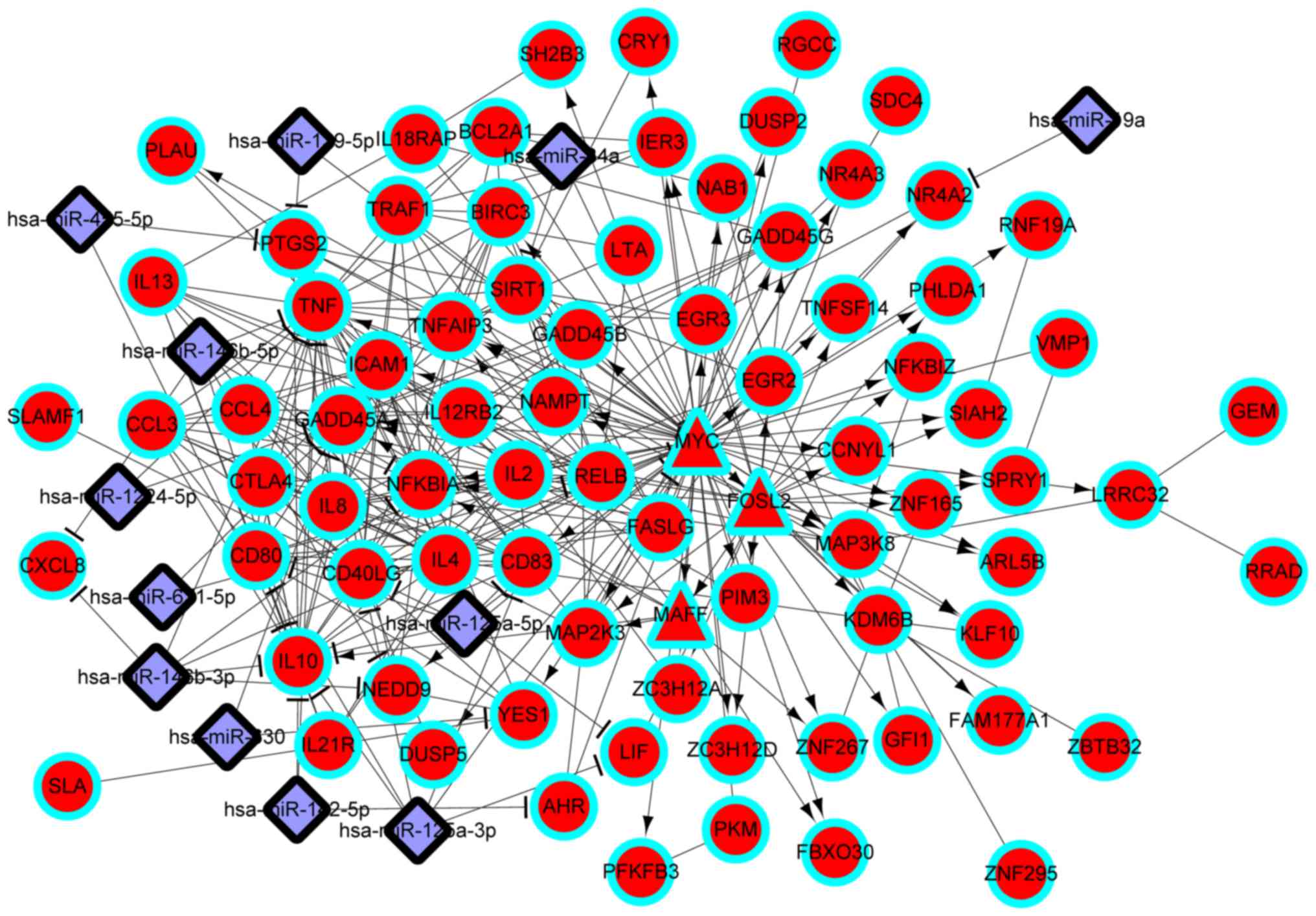Identification of key genes implicated in the suppressive function of human FOXP3+CD25+CD4+ regulatory T cells through the analysis of time‑series data
- Authors:
- Published online on: December 29, 2017 https://doi.org/10.3892/mmr.2017.8366
- Pages: 3647-3657
-
Copyright: © Bai et al. This is an open access article distributed under the terms of Creative Commons Attribution License.
Abstract
Introduction
Regulatory T cells (Tregs) are a subgroup of T cells that suppress proliferation of effector T cells, sustain tolerance to self-antigens and regulate the immune system (1). As a type of T cell that expresses cluster of differentiation (CD)4, CD25 and forkhead box P3 (FOXP3), human FOXP3+CD25+CD4+ Tregs are critical for maintaining immune homeostasis (2). Tregs are deemed to inhibit tumor immunity and contribute to the growth of cancerous cells, suggesting that high levels of Tregs may indicate poor prognosis for patients with cancer (3). A previous study also demonstrated that regulation of Tregs is conducive to autoimmune disease and organ transplantation (4). Therefore, it is necessary to explore the mechanisms implicated in Treg function.
Numerous genes have been reported to be associated with Treg function. For example, cytotoxic T lymphocyte antigen 4 may be important for the immune suppression of natural Tregs by affecting the activation effects of antigen-presenting cells on other T cells (5–7). Ectopic expression of lymphocyte-activation gene 3 can significantly weaken the proliferative capacity of CD4+ T cells and facilitate their inhibitory effect on effector T cells (8). Prostaglandin E2 (PGE2) promotes the mRNA and protein expression of FOXP3 and increases its promoter activity, thus suggesting that PGE2 in human lymphocytes may regulate FOXP3 expression and the function of Tregs (9,10). In vivo, toll-like receptor 2 (TLR2) modulates Treg function, thus indicating that TLRs may control immune responses via Tregs (11,12). Furthermore, a previous study demonstrated that indoleamine 2,3-dioxygenase 1 predominantly controls the response of Tregs to inflammatory stimuli in the physiological environment (13). Latent transforming growth factor-β is expressed on activated Tregs, and may serve a role in mechanisms underlying infectious tolerance and Treg-mediated suppression (14). In 2012, He et al (15) performed high time-resolution genome-wide gene expression analysis to investigate the genes involved in human Tregs; the results demonstrated that plasminogen activator urokinase was essential for the suppressive function of Tregs. Nevertheless, the potential molecular mechanisms underlying Treg function remain unclear.
The present study, using data deposited by He et al (15), further identified the key genes implicated in Treg function. After searching the microRNA (miRNA)-mRNA pairs, transcription factor (TF)-mRNA pairs and protein-protein interaction (PPI) relationships, regulatory networks and PPI networks were constructed and merged into integrated networks. Finally, enrichment analyses were performed for the genes involved in the PPI networks to predict their possible functions.
Materials and methods
Microarray data
GSE11292 microarray data were downloaded from the Gene Expression Omnibus (GEO, http://www.ncbi.nlm.nih.gov/geo/) database, based on the GPL570 [HG-U133_Plus_2] Affymetrix Human Genome U133 Plus 2.0 Array platform (Affymetrix, Inc., Santa Clara, CA, USA). To investigate the key genes important for human Treg function, data from Treg cells at 19 time points (0–360 min) with an equal interval of 20 min, and their corresponding repeated samples, were collected from GSE11292. Notably, data from Treg cells at the 120 min time point were missing. Briefly, the stable human Tregs isolated from peripheral blood were from the same batch of Tregs as used in a previous study by Probst-Kepper et al (16). Tregs were cultured in Iscove's modified Dulbecco's medium (Gibco; Thermo Fisher Scientific, Inc., Waltham, MA, USA) containing 10% fetal calf serum (Gibco; Thermo Fisher Scientific, Inc.), 50 µM µ-mercaptoethanol (Sigma-Aldrich; Merck KGaA, Darmstadt, Germany), 100 µg/ml streptomycin and 100 U/ml penicillin. Human Tregs were added with anti-CD3/anti-CD28-coated Dynabeads (Invitrogen; Thermo Fisher Scientific, Inc.) in a proportion of 1:1 and interleukin-2 (IL2; 100 U/ml; Novartis International AG, Basel, Switzerland) and were assigned into 1.5 ml microtubes (Eppendorf, Hamburg, Germany; 4×106 cells/tube) for each time point. The cells were stored at 4°C to settle the cells and beads, and then were cultured at 37°C (15). GSE11292 data used in the present study were downloaded from the public GEO database; therefore, ethical approval and patient consent were not required.
Data preprocessing and clustering analysis
Using the Affy package (17) in R, the raw data were preprocessed with background correction, quantile normalization, probe summarization and transformation from probe ID to gene symbol. Subsequently, soft clustering analysis was performed for the two group samples (Treg cells and their repeated samples) using the Mfuzz package (18,19). The parameters of minimum standard deviation and acore were set at 0.5 and 0.9, respectively.
Construction of regulatory networks
Combined with the validated miRNA-mRNA pairs in miRecords database (http://c1.accurascience.com/miRecords/) (20), and the predicted miRNA-mRNA pairs in miRanda (http://www.microrna.org) (21), MirTarget2 (http://mir db.org/miRDB) (22), PicTar (http://pictar.mdc-berlin.de) (23), PITA (https://genie.weizmann.ac.il/pubs/mir07/mir07_data.html) (24) and TargetScan (http://www.targetscan.org) (25) databases, the miRNA-mRNA relationships involving the genes in each cluster were predicted. P<0.05 and the involvement of at least 2 genes were used as the thresholds for screening significant miRNAs. Subsequently, the screened miRNA-mRNA pairs were visualized in miRNA-mRNA regulatory networks using Cytoscape software (http://www.cyto scape.org) (26).
Based on the transcriptional regulatory data in the ENCyclopedia of DNA Elements (ENCODE) project (http://www.genome.gov/Pages/Research/ENCODE) (27), the transcriptional regulatory relationships between the genes in each cluster were searched and identified. In addition, transcriptional regulatory networks were constructed using Cytoscape software (26).
PPI network construction and network integration
The STRING (28) database (http://string-db.org) was applied to perform a PPI analysis for the genes in each cluster. The PPI pairs with a combined score (required confidence) >0.4 were selected, after which, a PPI network was constructed using Cytoscape software (29). Nodes were considered proteins in the PPI network, whereas their degrees corresponded to the number of interactions associated with them. Nodes with higher degrees were considered hub nodes (30). Finally, the miRNA-mRNA regulatory network, transcriptional regulatory networks and PPI networks were integrated separately for the genes in each cluster.
Functional and pathway enrichment analyses
The Gene Ontology database (GO; http://www.geneontology.org/) classifies functions according to three terms: Molecular function, biological process and cellular component (31). The Kyoto Encyclopedia of Genes and Genomes database (KEGG; http://www.genome.jp/kegg/) contains information regarding biological systems from systemic functional, genomic and chemical aspects (32). Using Database for Annotation, Visualization and Integrated Discovery software (33), GO functional and KEGG pathway enrichment analyses were separately conducted for the genes involved in PPI networks. P<0.05 and the involvement of at least 2 genes were used as the thresholds for screening significant terms.
Results
Clustering analysis
After preprocessing, cluster 1 [including 292 genes; such as tripartite motif containing 28 (TRIM28) and GAPDH], cluster 2 (including 111 genes), cluster 3 (including 194 genes) and cluster 4 [including 103 genes; such as tumor necrosis factor (TNF)] were obtained from soft clustering analysis. Genes in cluster 1 were significantly downregulated after 200 min and were significantly upregulated after 300 min. Genes in cluster 2 were continually downregulated, whereas genes in cluster 3 were continually upregulated. Genes in cluster 4 were significantly upregulated prior to 80 min and expression flattened after that time point (Fig. 1).
Network construction and integration
Using the following thresholds: P<0.05 and targeting at least 2 genes, miRNAs targeting the genes [such as miRNA (miR)-146b-3p→TNF, miR-146b-5p→TNF and miR-142-5p→TNF] in each cluster were enriched (Table I). There were no miRNAs significantly enriched for the genes in cluster 2. Based on the ENCODE project, the transcriptional regulatory relationships between the genes in each cluster were searched and identified. In the transcriptional regulatory network for genes in cluster 1, GAPDH was targeted by TRIM28. However, no transcriptional regulatory relationships were found for the genes in cluster 3. There were 656, 40, 129 and 234 PPIs demonstrated in clusters 1, 2, 3 and 4. The top 10 nodes with the highest degrees in the PPI networks for each cluster are presented in Table II, including GAPDH (degree, 40) in cluster 1, Janus kinase 2 (JAK2; degree, 10) and signal transducer and activator of transcription 5A (STAT5A; degree, 9) in cluster 3, and TNF (degree, 26) and IL2 (degree, 22) in cluster 4. Finally, the regulatory and PPI networks were integrated separately for the genes in clusters 1 (Fig. 2), 2 (Fig. 3), 3 (Fig. 4) and 4 (Fig. 5).
Table II.Top 10 nodes with higher degrees in the protein-protein interaction networks for each cluster. |
Functional and pathway enrichment analyses
GO functional and KEGG pathway enrichment analyses were conducted for the genes involved in the PPI networks. The top 10 functions enriched for the genes involved in the PPI networks are listed in Table III. Genes in the PPI networks were enriched in functions including negative regulation of protein metabolic process (cluster 1; P=2.39×10−9), defense response (cluster 2; P=2.84×10−3), response to organic substance (cluster 3; P=2.20×10−5), and immune response (cluster 4; P=3.43×10−8; which involved IL2 and TNF). The top 10 pathways enriched for the genes involved in the PPI networks are presented in Table IV, including proteasome (cluster 1; P=8.10×10−4), toll-like receptor signaling pathway (cluster 2; P=2.26×10−2), cytokine-cytokine receptor interaction (cluster 3; P=6.80×10−4), and T cell receptor signaling pathway (cluster 4; P=1.41×10−5; which involved IL2 and TNF).
Table IV.The pathways enriched for the genes involved in protein-protein interaction networks (only the top 10 pathways are presented for cluster 4). |
Discussion
In the present study, cluster 1 (including 292 genes), cluster 2 (including 111 genes), cluster 3 (including 194 genes) and cluster 4 (including 103 genes) were obtained from soft clustering analysis. Genes in cluster 1 were significantly downregulated after 200 min and were significantly upregulated after 300 min. Genes in cluster 2 and cluster 3 had evidently opposite tendencies. Genes in cluster 4 were significantly upregulated prior to 80 min and expression plateaued thereafter. The miRNA-mRNA pairs, TF-mRNA pairs and PPI relationships were searched, respectively. There were no miRNAs significantly enriched for the genes in cluster 2, and no transcriptional regulatory relationships were determined for the genes in cluster 3. There were 656, 40, 129 and 234 PPIs for genes in clusters 1, 2, 3 and 4, respectively. In particular, GAPDH (degree, 40) in cluster 1, JAK2 (degree, 10) and STAT5A (degree, 9) in cluster 3, and TNF (degree, 26) and IL2 (degree, 22) in cluster 4 exhibited high degrees in the PPI networks.
The gapA gene that encodes GAPDH is conserved in numerous serotypes of Haemophilus parasuis, and the GAPDH (pCgap) DNA vaccine may contribute to the immune response and inhibit infection with H. parasuis (34). A previous study demonstrated that GAPDH in Streptococcus agalactiae can function as a virulence-associated immunomodulatory protein (35). As a component of heterochromatin complexes, TRIM28 is phosphorylated following stimulation by the T cell antigen receptor, and is implicated in T cell activation and tolerance (36). In the transcriptional regulatory network for genes in cluster 1, GAPDH was targeted by TRIM28, indicating that TRIM28 may have a role in Treg function through targeting GAPDH. JAK2 propagates receptor-binding signals through inflammatory cytokines, and can serve as a relevant biological target in the control of allograft rejection or grading acute graft-versus-host disease without broader immune impairment (37). Genome-wide association studies have reported that the JAK-STAT signaling pathway is highly correlated with human autoimmunity, and targeting various JAKs has been applied in immune-mediated disease (38). These findings indicated that JAK2 may also be associated with Treg function.
In the miRNA-mRNA regulatory network for genes in cluster 4, TNF was targeted by miR-146b-3p, miR-146b-5p and miR-142-5p. Suppression or stimulation of the costimulators of TNF receptor family (TNFR) members may be used to treat cancer, autoimmunity, infectious disease and transplantation (39). Through quantitative polymerase chain reaction and flow cytometry, previous studies have indicated that anti-TNF antibody (infliximab) can increase FOXP3 expression in CD4+CD25high Tregs and restore the suppressive function of Tregs, thus suggesting that TNF may have a role in controlling autoimmunity through suppressing CD4+CD25+ Treg activity (40,41). In addition, the stimulation of glucocorticoid-induced TNFR-related protein conquers self-tolerance/ignorance and promotes T cell-mediated antitumor activity with minimal autoimmunity (42,43). miR-146a is ubiquitously expressed in Tregs and has an important role in congenital and acquired immune responses (44,45). The results of a western blot analysis and enzyme-linked immunosorbent assay indicated that miR-142-3p controls the levels of cyclic adenosine monophosphate via regulating adenylyl cyclase 9 mRNA in CD4+CD25+ Treg cells and CD4+CD25− T cells (46,47). Therefore, miR-146b-3p, miR-146b-5p and miR-142-5p may serve roles in Treg function via regulating TNF.
STAT5 binds to the FOXP3 promoter, indicating that activation of IL-2 receptor β-dependent STAT5 contributes to Treg differentiation by mediating FOXP3 expression (48). STAT5a/b have been demonstrated to serve a nonredundant, essential role in regulating Tregs, and have an opposing role compared with STAT3 in regulating FOXP3 (49). Flow cytometric analysis indicated that STAT5B transfers a crucial IL-2-mediated signal that promotes the accumulation of functional Tregs in vivo (50). STAT5 activation maintains the expression of FOXP3 in CD4+CD25− effector T cells and Tregs, thus indicating the influential role of cytokines on FOXP3 expression (51). These findings indicated that IL2 and STAT5A may be implicated in Treg function. Enrichment analyses demonstrated that IL2 and TNF were enriched in immune response and T cell receptor signaling pathway, suggesting that IL2 and TNF may affect Treg function via the immune response and T cell receptor signaling pathway.
In conclusion, cluster 1 (including 292 genes), cluster 2 (including 111 genes), cluster 3 (including 194 genes) and cluster 4 (including 103 genes) were obtained from a soft clustering analysis. Subsequently, GAPDH was revealed to be targeted by TRIM28, and TNF was targeted by miR-146b-3p, miR-146b-5p and miR-142-5p; these interactions in addition to JAK2, IL2 and STAT5A may have important roles in Treg function. However, these findings, which were obtained by bioinformatics analysis, require further experimental verification.
Acknowledgements
The present study was supported by the National Natural Science Foundation of China (grant no. 81260112) and the Governor's Foundation for Excellent Talents of Science and Technology in Guizhou Province [grant no. (2009) 31].
References
|
Thompson C and Powrie F: Regulatory T cells. Curr Opin Pharmacol. 4:408–414. 2004. View Article : Google Scholar : PubMed/NCBI | |
|
Curiel TJ: Tregs and rethinking cancer immunotherapy. J Clin Invest. 117:1167–1174. 2007. View Article : Google Scholar : PubMed/NCBI | |
|
Adeegbe DO and Nishikawa H: Natural and induced T regulatory cells in cancer. Front immunol. 4:1902013. View Article : Google Scholar : PubMed/NCBI | |
|
Afzali B, Lombardi G, Lechler RI and Lord GM: The role of T helper 17 (Th17) and regulatory T cells (Treg) in human organ transplantation and autoimmune disease. Clin Exp Immunol. 148:32–46. 2007. View Article : Google Scholar : PubMed/NCBI | |
|
Wing K, Onishi Y, Prieto-Martin P, Yamaguchi T, Miyara M, Fehervari Z, Nomura T and Sakaguchi S: CTLA-4 control over Foxp3+ regulatory T cell function. Science. 322:271–275. 2008. View Article : Google Scholar : PubMed/NCBI | |
|
Tai X, Van Laethem F, Pobezinsky L, Guinter T, Sharrow SO, Adams A, Granger L, Kruhlak M, Lindsten T, Thompson CB, et al: Basis of CTLA-4 function in regulatory and conventional CD4+ T cells. Blood. 119:5155–5163. 2012. View Article : Google Scholar : PubMed/NCBI | |
|
Sansom DM and Walker LS: The role of CD28 and cytotoxic T-lymphocyte antigen-4 (CTLA-4) in regulatory T-cell biology. Immunol Rev. 212:131–148. 2006. View Article : Google Scholar : PubMed/NCBI | |
|
Huang CT, Workman CJ, Flies D, Pan X, Marson AL, Zhou G, Hipkiss EL, Ravi S, Kowalski J, Levitsky HI, et al: Role of LAG-3 in regulatory T cells. Immunity. 21:503–513. 2004. View Article : Google Scholar : PubMed/NCBI | |
|
Baratelli F, Lin Y, Zhu L, Yang SC, Heuzé-Vourc'h N, Zeng G, Reckamp K, Dohadwala M, Sharma S and Dubinett SM: Prostaglandin E2 induces FOXP3 gene expression and T regulatory cell function in human CD4+ T cells. J Immunol. 175:1483–1490. 2005. View Article : Google Scholar : PubMed/NCBI | |
|
Li J, Feng G, Liu J, Rong R, Luo F, Guo L, Zhu T, Wang G and Chu Y: Renal cell carcinoma may evade the immune system by converting CD4+ Foxp3-T cells into CD4+ CD25+ Foxp3+ regulatory T cells: Role of tumor COX-2-derived PGE2. Mol Med Rep. 3:959–963. 2010.PubMed/NCBI | |
|
Sutmuller RP, den Brok MH, Kramer M, Bennink EJ, Toonen LW, Kullberg BJ, Joosten LA, Akira S, Netea MG and Adema GJ: Toll-like receptor 2 controls expansion and function of regulatory T cells. J Clin Invest. 116:485–494. 2006. View Article : Google Scholar : PubMed/NCBI | |
|
Zhang Y, Luo F, Cai Y, Liu N, Wang L, Xu D and Chu Y: TLR1/TLR2 agonist induces tumor regression by reciprocal modulation of effector and regulatory T cells. J Immunol. 186:1963–1969. 2011. View Article : Google Scholar : PubMed/NCBI | |
|
Baban B, Chandler PR, Sharma MD, Pihkala J, Koni PA, Munn DH and Mellor AL: IDO activates regulatory T cells and blocks their conversion into Th17-like T cells. J Immunol. 183:2475–2483. 2009. View Article : Google Scholar : PubMed/NCBI | |
|
Tran DQ, Andersson J, Wang R, Ramsey H, Unutmaz D and Shevach EM: GARP (LRRC32) is essential for the surface expression of latent TGF-beta on platelets and activated FOXP3+ regulatory T cells. Proc Natl Acad Sci USA. 106:pp. 13445–13450. 2009; View Article : Google Scholar : PubMed/NCBI | |
|
He F, Chen H, Probst-Kepper M, Geffers R, Eifes S, Del Sol A, Schughart K, Zeng AP and Balling R: PLAU inferred from a correlation network is critical for suppressor function of regulatory T cells. Mol Syst Biol. 8:6242012. View Article : Google Scholar : PubMed/NCBI | |
|
Probst-Kepper M, Geffers R, Kröger A, Viegas N, Erck C, Hecht HJ, Lünsdorf H, Roubin R, Moharregh-Khiabani D, Wagner K, et al: GARP: A key receptor controlling FOXP3 in human regulatory T cells. J Cell Mol Med. 13:3343–3357. 2009. View Article : Google Scholar : PubMed/NCBI | |
|
Gautier L, Cope L, Bolstad BM and Irizarry RA: affy-analysis of Affymetrix GeneChip data at the probe level. Bioinformatics. 20:307–315. 2004. View Article : Google Scholar : PubMed/NCBI | |
|
Futschik ME and Carlisle B: Noise-robust soft clustering of gene expression time-course data. J Bioinform Comput Biol. 3:965–988. 2005. View Article : Google Scholar : PubMed/NCBI | |
|
Kumar L and Futschik E: Mfuzz: A software package for soft clustering of microarray data. Bioinformation. 2:5–7. 2007. View Article : Google Scholar : PubMed/NCBI | |
|
Xiao F, Zuo Z, Cai G, Kang S, Gao X and Li T: miRecords: An integrated resource for microRNA-target interactions. Nucleic Acids Res. 37:D105–D110. 2009. View Article : Google Scholar : PubMed/NCBI | |
|
Enright AJ, John B, Gaul U, Tuschl T, Sander C and Marks DS: MicroRNA targets in Drosophila. Genome Biol. 5:R12003. View Article : Google Scholar : PubMed/NCBI | |
|
Wang X: miRDB: A microRNA target prediction and functional annotation database with a wiki interface. RNA. 14:1012–1017. 2008. View Article : Google Scholar : PubMed/NCBI | |
|
Krek A, Grün D, Poy MN, Wolf R, Rosenberg L, Epstein EJ, MacMenamin P, da Piedade I, Gunsalus KC, Stoffel M and Rajewsky N: Combinatorial microRNA target predictions. Nat Genet. 37:495–500. 2005. View Article : Google Scholar : PubMed/NCBI | |
|
Kertesz M, Iovino N, Unnerstall U, Gaul U and Segal E: The role of site accessibility in microRNA target recognition. Nat Genet. 39:1278–1284. 2007. View Article : Google Scholar : PubMed/NCBI | |
|
Lewis BP, Burge CB and Bartel DP: Conserved seed pairing, often flanked by adenosines, indicates that thousands of human genes are microRNA targets. cell. 120:15–20. 2005. View Article : Google Scholar : PubMed/NCBI | |
|
Kohl M, Wiese S and Warscheid B: Cytoscape: Software for visualization and analysis of biological networks. Methods Mol Biol. 696:291–303. 2011. View Article : Google Scholar : PubMed/NCBI | |
|
Raney BJ, Cline MS, Rosenbloom KR, Dreszer TR, Learned K, Barber GP, Meyer LR, Sloan CA, Malladi VS, Roskin KM, et al: ENCODE whole-genome data in the UCSC genome browser (2011 update). Nucleic Acids Res. 39:D871–D875. 2011. View Article : Google Scholar : PubMed/NCBI | |
|
Von Mering C, Jensen LJ, Kuhn M, Chaffron S, Doerks T, Krüger B, Snel B and Bork P: STRING 7-recent developments in the integration and prediction of protein interactions. Nucleic Acids Res. 35:D358–D362. 2007. View Article : Google Scholar : PubMed/NCBI | |
|
Saito R, Smoot ME, Ono K, Ruscheinski J, Wang PL, Lotia S, Pico AR, Bader GD and Ideker T: A travel guide to Cytoscape plugins. Nat Methods. 9:1069–1076. 2012. View Article : Google Scholar : PubMed/NCBI | |
|
He X and Zhang J: Why do hubs tend to be essential in protein networks? PLoS Genet. 2:e882006. View Article : Google Scholar : PubMed/NCBI | |
|
Binns D, Dimmer E, Huntley R, Barrell D, O'Donovan C and Apweiler R: QuickGO: A web-based tool for gene ontology searching. Bioinformatics. 25:3045–3046. 2009. View Article : Google Scholar : PubMed/NCBI | |
|
Kanehisa M, Araki M, Goto S, Hattori M, Hirakawa M, Itoh M, Katayama T, Kawashima S, Okuda S, Tokimatsu T and Yamanishi Y: KEGG for linking genomes to life and the environment. Nucleic Acids Res. 36:D480–D484. 2008. View Article : Google Scholar : PubMed/NCBI | |
|
Huang DW, Sherman BT, Tan Q, Collins JR, Alvord WG, Roayaei J, Stephens R, Baseler MW, Lane HC and Lempicki RA: The DAVID gene functional classification tool: A novel biological module-centric algorithm to functionally analyze large gene lists. Genome Biol. 8:R1832007. View Article : Google Scholar : PubMed/NCBI | |
|
Fu S, Zhang M, Ou J, Liu H, Tan C, Liu J, Chen H and Bei W: Construction and immune effect of Haemophilus parasuis DNA vaccine encoding glyceraldehyde-3-phosphate dehydrogenase (GAPDH) in mice. Vaccine. 30:6839–6844. 2012. View Article : Google Scholar : PubMed/NCBI | |
|
Madureira P, Baptista M, Vieira M, Liu H, Tan C, Liu J, Chen H and Bei W: Streptococcus agalactiae GAPDH is a virulence-associated immunomodulatory protein. J Immunol. 178:1379–1387. 2007. View Article : Google Scholar : PubMed/NCBI | |
|
Chikuma S, Suita N, Okazaki IM, Shibayama S and Honjo T: TRIM28 prevents autoinflammatory T cell development in vivo. Nat Immunol. 13:596–603. 2012. View Article : Google Scholar : PubMed/NCBI | |
|
Betts BC, Abdel-Wahab O, Curran SA, St Angelo ET, Koppikar P, Heller G, Levine RL and Young JW: Janus kinase-2 inhibition induces durable tolerance to alloantigen by human dendritic cell-stimulated T cells yet preserves immunity to recall antigen. Blood. 118:5330–5339. 2011. View Article : Google Scholar : PubMed/NCBI | |
|
O'Shea JJ and Plenge R: JAK and STAT signaling molecules in immunoregulation and immune-mediated disease. Immunity. 36:542–550. 2012. View Article : Google Scholar : PubMed/NCBI | |
|
Watts TH: TNF/TNFR family members in costimulation of T cell responses. Annu Rev Immunol. 23:23–68. 2005. View Article : Google Scholar : PubMed/NCBI | |
|
Valencia X, Stephens G, Goldbach-Mansky R, Wilson M, Shevach EM and Lipsky PE: TNF downmodulates the function of human CD4+ CD25hi T-regulatory cells. Blood. 108:253–261. 2006. View Article : Google Scholar : PubMed/NCBI | |
|
Croft M: The role of TNF superfamily members in T-cell function and diseases. Nature Reviews Immunology. 9:271–285. 2009. View Article : Google Scholar : PubMed/NCBI | |
|
Ramirez-Montagut T, Chow A, Hirschhorn-Cymerman D, Terwey TH, Kochman AA, Lu S, Miles RC, Sakaguchi S, Houghton AN and van den Brink MR: Glucocorticoid-induced TNF receptor family related gene activation overcomes tolerance/ignorance to melanoma differentiation antigens and enhances antitumor immunity. J Immunol. 176:6434–6442. 2006. View Article : Google Scholar : PubMed/NCBI | |
|
Kanamaru F, Youngnak P, Hashiguchi M, Nishioka T, Takahashi T, Sakaguchi S, Ishikawa I and Azuma M: Costimulation via glucocorticoid-induced TNF receptor in both conventional and CD25+ regulatory CD4+ T cells. J Immunol. 172:7306–7314. 2004. View Article : Google Scholar : PubMed/NCBI | |
|
Rusca N and Monticelli S: MiR-146a in immunity and disease. Mol Biol Int. 2011:4373012011. View Article : Google Scholar : PubMed/NCBI | |
|
Lu LF, Boldin MP, Chaudhry A, Lin LL, Taganov KD, Hanada T, Yoshimura A, Baltimore D and Rudensky AY: Function of miR-146a in controlling Treg cell-mediated regulation of Th1 responses. Cell. 142:914–929. 2010. View Article : Google Scholar : PubMed/NCBI | |
|
Huang B, Zhao J, Lei Z, Shen S, Li D, Shen GX, Zhang GM and Feng ZH: miR-142-3p restricts cAMP production in CD4+ CD25-T cells and CD4+ CD25+ TREG cells by targeting AC9 mRNA. EMBO Rep. 10:180–185. 2009. View Article : Google Scholar : PubMed/NCBI | |
|
Lv M, Zhang X, Jia H, Li D, Zhang B, Zhang H, Hong M, Jiang T, Jiang Q, Lu J, et al: An oncogenic role of miR-142-3p in human T-cell acute lymphoblastic leukemia (T-ALL) by targeting glucocorticoid receptor-α and cAMP/PKA pathways. Leukemia. 26:769–777. 2012. View Article : Google Scholar : PubMed/NCBI | |
|
Burchill MA, Yang J, Vogtenhuber C, Blazar BR and Farrar MA: IL-2 receptor β-dependent STAT5 activation is required for the development of Foxp3+ regulatory T cells. J Immunol. 178:280–290. 2007. View Article : Google Scholar : PubMed/NCBI | |
|
Yao Z, Kanno Y, Kerenyi M, Stephens G, Durant L, Watford WT, Laurence A, Robinson GW, Shevach EM, Moriggl R, et al: Nonredundant roles for Stat5a/b in directly regulating Foxp3. Blood. 109:4368–4375. 2007. View Article : Google Scholar : PubMed/NCBI | |
|
Cohen AC, Nadeau KC, Tu W, Hwa V, Dionis K, Bezrodnik L, Teper A, Gaillard M, Heinrich J, Krensky AM, et al: Cutting edge: Decreased accumulation and regulatory function of CD4+ CD25high T cells in human STAT5b deficiency. J Immunol. 177:2770–2774. 2006. View Article : Google Scholar : PubMed/NCBI | |
|
Tamiya T, Kashiwagi I, Takahashi R, Yasukawa H and Yoshimura A: Suppressors of cytokine signaling (SOCS) proteins and JAK/STAT pathways regulation of T-Cell inflammation by SOCS1 and SOCS3. Arterioscler Thromb Vasc Biol. 31:980–985. 2011. View Article : Google Scholar : PubMed/NCBI |



